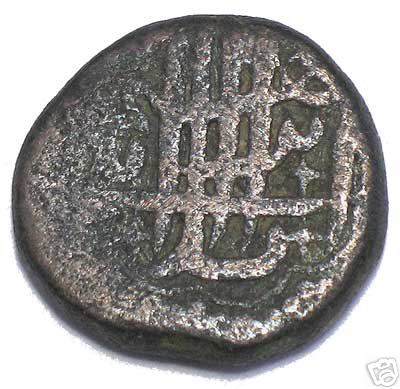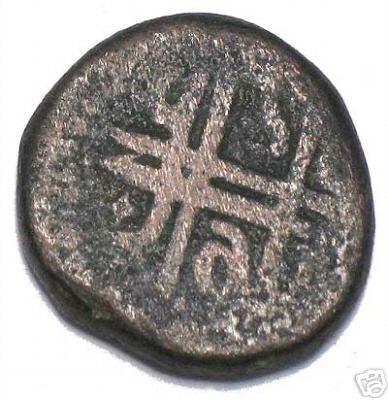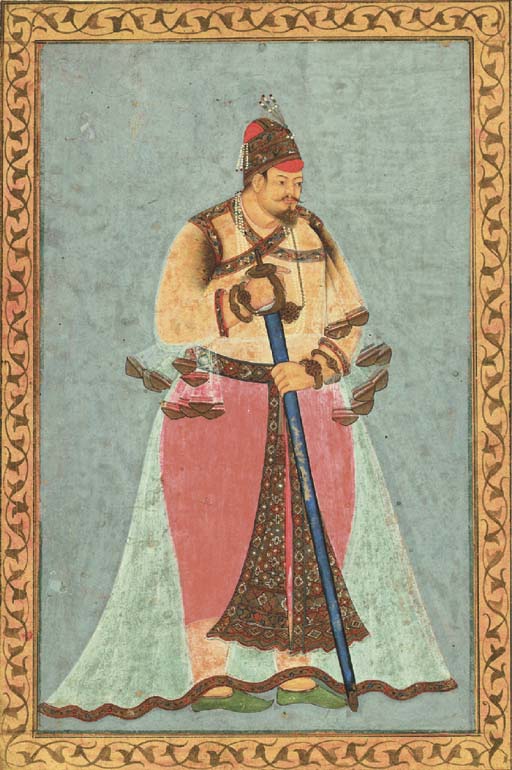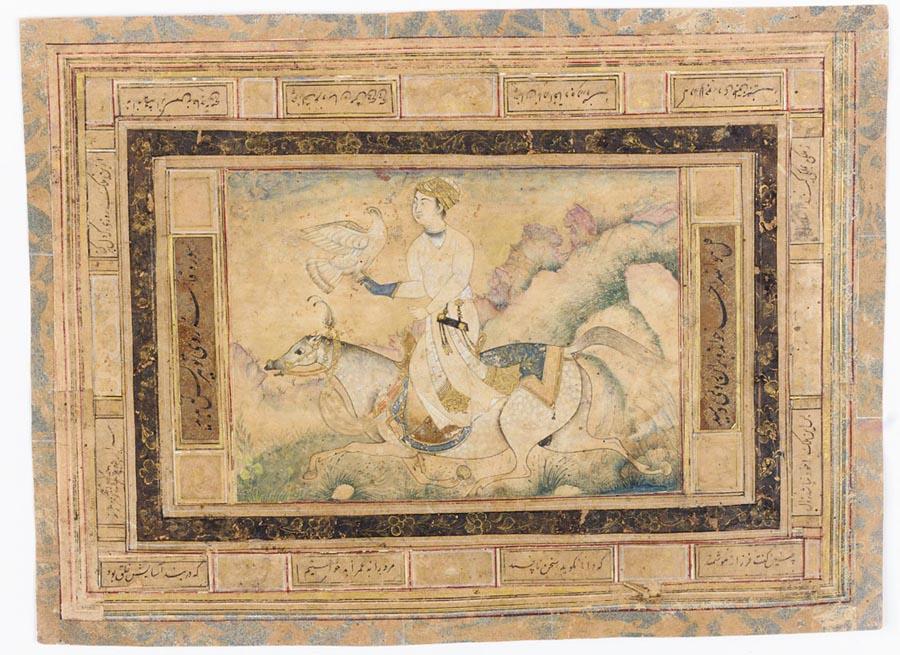 |
 |
 |
 |
A copper coin minted by Ibrahim Adil Shah II
Source: ebay, June 2007

Ibrahim 'Adil Shah II (r.1579-1627), a 17th-century Deccani painting
Source: http://www.christies.com/LotFinder/search/LotDetail.asp?sid=&intObjectID=3879091&SE=CMWCAT04+219911+%2D1746083765+&QR=M+1+106+Aqc0000900+204159++Aqc0000900+&entry=india&SU=1&RQ=True&AN=107
(downloaded Mar. 2002)
"A Portrait of Ibrahim Adil Shah II (r.1579-1627). India, Deccan, 17th Century. Depicting the corpulent sultan set against a blue-gray ground in a salmon colored jama and transparent robes with foliate hems and colorful lattice motif sash painted on gold, wearing gold and pearl jewelry and orange headdress while holding a sheathed sword, with peach colored border painted with gold foliate scrolls and mounted in an ivory colored album page with gold flecks, bearing Nastaliq inscription at top; the reverse with flowering poppies in a rectangular frame. Folio: 13¼ x 9 in. (33.5 x 23 cm.).
Lot Notes: Ibrahim Adil Shah II ruled in the Deccan Plains of Bijapur. Like his Mughal contemporary in the north, Akbar, he was tolerant of non-Islamic traditions and commissioned numerous works with Hindu themes. With a mystical bearing, he also achieved renown as a poet and great patron of the arts. Compare to a posthumous portrait discussed by P. Pal, Indian Painting, 1993 p. 331, where the author states that the absence of the rudraksha Hindu beads often depicted on portraits of Adil Shah II) and idealization of the face were the result of greater Mughal influence in the region, whereas the proportions of Adil Shah's figure and the swing of his sash are reminiscent of a well-known early 17th century portrait in The British Museum attributed to the Bodeleian painter, cf. M. Zebrowski, Deccani Painting, 1983, pl. VIII."

A Deccani courtier who may or may not be the king himself, c.1600
Source: http://search.sothebys.com/jsps/live/lot/LotDetail.jsp?lot_id=4DV8Y
(downloaded Mar. 2005)
"PORTRAIT OF A DECCANI COURTIER, POSSIBLY ADIL SHAH II, ON HORSEBACK, STYLE OF FARRUKH BEG, BIJAPUR, DECCAN, INDIA, CIRCA 1600. Measurements note: panel 10.2 by 14cm.leaf 19.5 by 27cm.
DESCRIPTION: pen and gouache heightened with gold on paper, laid down on stout paper with borders incorporating panels of nasta'liq calligraphy, central panel with a courtier on horseback carrying a hawk on his right hand and riding through a rocky landscape
CATALOGUE NOTE: This impressive portrait is strikingly similar to a portrait from the Leningrad Album hailed by Zebrowski as "the most poetic Bijapuri portrait to have survived," depicting the Deccani ruler Ibrahim Adil Shah II (r.1579-1627) hawking (Zebrowski 1983, pl.ix, p.89). The central figure with his outstretched arm, blue gauntlet and snowy eagle, cantering through a rocky landscape on a piebald horse is closely comparable in both subject matter and style to this example. Other features exhibited in the present lot are comparable to the Leningrad album page and suggest that it too is a royal portrait, the facial type with pursed lips, aquiline nose and rounded cheeks distinctly recalls portraits of Sultan Ibrahim Adil Shah II (see Zebrowski 1983, pl.vi, p.54 and pl.50, p.75).
Akbar's contemporary, Sultan Ibrahim II, was an active patron of the arts who encouraged all manner of artists, whether poets, musicians or painters, in their creative endeavours. A contemporary poem by the sultan's poet laureate, Zhuhuri, describes his support of the arts in fulsome terms, "no thorn in the path of Art ever pierced a man's foot but he picked up gardens of flowers... from... [Ibrahim's] favour... and in nothing was the excellence of Art hidden but his discernment openly fell in love with it." (Zebrowski 1983, p.68). This praise is not just the flattery of a courtier, documentary evidence supports these claims through other means. Poets, painters and calligraphers are all recorded as distinguished members of the sultan's inner circle, and the explicit mention of the painter's name, Farrukh Hussain, indicates the esteem in which he was held.
The Deccani and Mughal artistic traditions are deeply tied to one another both stylistically and in practice. For example, the nascent Deccani school of the 1560s and 70s owes much to the Mughal atelier in its representation of body mass and movement, whilst during the following century Mughal artists are known to have specialized in painting in a Deccani style and to have copied Deccani works. However the Deccani school developed an earthier, more direct expressiveness absent in the restraint and formality of the Mughal type. Deccani masters plunge their portrait subjects into semi darkness through dramatic shading and sculpt dream-like landscapes from fantastic palettes that recall the earlier traditions of Bijapur.
Whilst this portrait does not exhibit all the distinctive characteristics of the Deccani school and the later portrait of Adil Shah II hawking on horseback, it is possible to suggest that this painting was produced shortly after the artist Farrukh Beg moved from the Mughal court in 1600, importing a cooler palette with the Safavid aesthetic that he expounded."
== Indian Routes index == Indian Routes sitemap == Glossary == FWP's main page ==